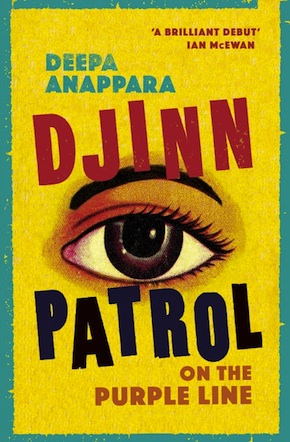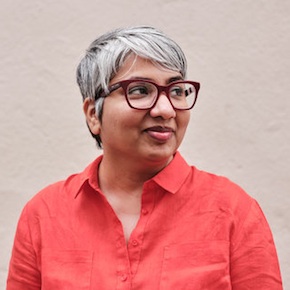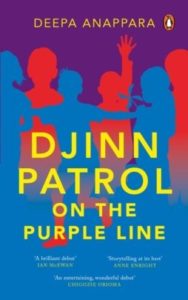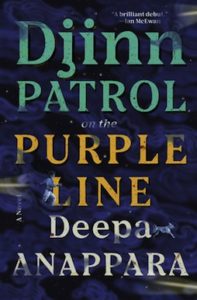Deepa Anappara: Other realities
by Mark Reynolds
“Rich with easy joy, heat and mystery… so vibrantly woven.” The New York Times
Deepa Anappara’s debut novel Djinn Patrol on the Purple Line is an exuberant and captivating child’s-eye depiction of hand-to-mouth living in a sprawling, determinedly self-sustaining slum in an unnamed Indian city. Nine-year-old narrator Jai is a fan of reality cop shows beamed into his family’s one-room shack in a crowded basti surrounded by the high-rise apartment blocks of the well-to-do, in which many of the slum’s mothers work long hours as maids. When children start to go missing, and the local police turn a blind eye, Jai rounds up his schoolfriends Pari and Faiz into a rag-tag patrol to do some ‘detectiving’ of their own.
This fictional world is informed by Deepa’s award-winning journalism on poverty, religious violence and education in Delhi, Mumbai and beyond, and in the novel’s afterword she pays tribute to the “resilience, cheerfulness and swagger” of the street children she met as a reporter. At the centre of the action, Jai is a picture of innocence, wonder and spirited resourcefulness in the face of fear, violence and heartbreak.
“I think when you’re writing about poverty, there’s always a danger that people don’t see beyond the characters’ circumstances, and they just get reduced to their problems,” she says. “Many of the children I interviewed, even if they were working or out on the street, still managed to hold on to their cheerfulness, and I wanted to capture that in these characters.”
These are kids with practically nothing, but they have ambitions, there’s love and camaraderie, and they work hard at school. “You’ll see that many of these parents send their children to English-medium schools,” says Deepa, “because they know that if the kids can speak and read English they’ve got a better chance at careers they themselves can’t have as manual labourers or housemaids. They all have that aspiration.
“Schooling is free in India for most children, there’s universal education for all, and there are other attractions as well, for instance the midday meal, which the Indian government introduced so there would be an incentive for kids to come to school; the certainty that they’ll get one meal a day.”
At heart this is a realistic novel. I wanted to stay true to what happens when there is so much apathy on the part of the government and society.”
Jai’s fantasy detective work also plugs into “the narratives we craft to make sense of sadness and chaos… and all the ways in which such stories may comfort or even fail us.” At all ages we often kid ourselves to make things feel better than they actually are. “I think we all try to make sense of what we can’t understand through stories,” she says. “For the children, the stories about ghosts and spirits, or Jai and his friends playing detective, is how they can cope. For the longest time Jai tries to believe in himself and in his own indestructibility, which you have as a child, but the circumstances are severely challenging. The police are not helping, politicians are not helping, all the institutions of the state that are meant to protect them aren’t doing their job, and they don’t have anywhere else to turn to. At heart this is a realistic novel, and I wanted to stay true to what happens when there is so much apathy on the part of the government and society at large.”
The evils that lurk around the slum include child-trafficking and kidnapping, but also groups of vigilantes who are stoked into hatred by those in power – which is another type of narrative that fails us. “It’s true in India as it is elsewhere across the world that, especially during times of stress, there’s an unwillingness to look inwards, and instead blame is placed on whoever’s living on the margins. In India right now there is a government that is very actively trying to exclude Muslims from the country’s citizenship, and there are government policies that are quite alienating towards a community. If you are not insulated by wealth and power, that sort of discrimination occurs daily. You don’t get a place to live, or you’re barred from entering somewhere because you’re Muslim. A lot of people in power are not being scrutinised because they’re so busy blaming somebody else. And it’s a particular issue when you’re living in poverty, and you can’t have those high walls to keep the world out.”
The kids are fully aware of the discrimination going on around them. Faiz is Muslim, and Jai worries he may be forced to leave their school and his home. “As a reporter, I also interviewed children who had been displaced by religious violence, and people who couldn’t go back to where they lived because there had been riots and the majority community would not let them come back to where they had grown up. Many of these children had to drop out of school and were working, but they still talked about wanting to become a pilot or a doctor; there was still some sort of hope that this would be possible. So I wanted to capture that awareness of what’s going on, but still tempered by hope and innocence, and perhaps naivety.”
Jai’s super-smart schoolfriend Pari and older sister Runu, who’s a gifted athlete, offer a glimpse of a hopeful future for young girls in modern India. “I had to be careful not to just show children as being exceptional,” says Deepa. “I think every child deserves to have a future, it’s not that someone should get ahead in life just because they’re bright or can run very fast. But at the same time I also wanted to portray my own experience growing up in a very patriarchal, very conservative society that didn’t quite understand your ambitions because there were certain rules as to what you had to do as a woman and as a girl. And this is still true of India today, there is a very strong patriarchy at work. But I wanted to show how within all those constraints and limits that are placed on a girl, they still try to do as much as they can, and I think this is not just true about Pari and Runu, but also Jai’s mother and their neighbour Shanti, both of whom are role models and protectors. Jai has certain views that have been created in him because of the privilege of his gender, and he has absorbed some of the things he has heard about women, but his views are challenged by all the women around him who don’t particularly behave in ways he expects. So part of this is a coming-of-age story about him understanding how patriarchy works, not as a polemic but through his interactions with the girls and the women in his life.”
In most news reports of actual disappearances, I didn’t feel as if I knew who these children were. They were pretty much absent, except as names or as numbers.”
The idleness and corruption of the police inflates the amateur sleuthing and speculation among the slum dwellers and wider society. “When I lived in Delhi there were several crimes against children that came to light, but because of police inaction and inefficiency there were lots of gaps in the investigations, people tried to fill in what was happening through speculation. This can be quite reductive, because you stop seeing the person to whom this horrible crime has happened, it becomes just a story.
“In my experience, in most true-crime podcasts or news reports of actual disappearances, I didn’t feel as if I knew who these children were. They were pretty much absent, except as names or as numbers. It’s also true that every narration is unreliable, I guess, because you don’t really reveal who you are even to yourself, but that is the closest fount of access you have, which is why I wanted the disappeared children each to have their own chapter.”
The disappeared include Bahadur, a budding engineer who has been sneaking away to Bhoot Bazaar on nights his mother is working, to avoid beatings from his drunken father. Omvir, the son of a struggling ‘press-wallah’, collects and delivers laundry for his father to try and keep him from debt, while harbouring dreams of becoming a Bollywood dancer. Then there’s teenage beautician Aanchal, who is snatched after a hopeful date with her higher-caste boyfriend; little Chandni, who popped out at night to surprise her overworked elder sister with a sweet treat; and Kabir and Khadifa, the Muslim brother and sister whose disappearance finally quells suspicion of a Muslim gang picking off Hindu children.
“It’s not that I started a spreadsheet and I knew where the story was going,” reflects Deepa. “For me, the creation of characters and what was happening to them was much more organic. The children I have written I essentially drew from my journalism and the kind of children that I met. Some of them wanted to be on reality TV, because there’s TV in almost every home. The children access whatever they can, be it through books from the free reading centre that show them a different world, or others like Jai who rely on TV and popular culture to create their own futures.”
Popular culture combines with wild imagination in folklore about djinns and ghosts. “I think we have to appreciate that people believe in djinns, just as they believe in gods,” says Deepa. “It wouldn’t be considered something unnatural, that belief, it’s part of daily life. Jai has picked up from Faiz that it might be djinns who are snatching the children, and for him it’s something that deserves due consideration. So we see him wrestle with his views as he’s trying to figure out how much the supernatural spirits are at work.”
The whole sweep of the novel is very cinematic, and there has been a sniff of TV interest. “It’s been optioned,” says Deepa, “ but it’s too early to say if anything will come out of that.” If it were to happen, with the right casting (think of the wonderfully natural child actors in Garth Davis’ Lion, Nadine Labaki’s Capernaum or Saverio Costanzo’s My Brilliant Friend), it would be an outstanding, immersive treat.
Deepa credits Stranger Things and Super 8 as touchstones, in terms of the supernatural elements and the bonds the children forge. “I also drew from the sort of camaraderie you see in children’s detective books,” she adds, “but I did want to write it in a particular context. I didn’t see any detective stories which had people who look like me in them when I was growing up, so that was definitely one of the things I wanted to do.
“There’s also a book by Tayari Jones called Leaving Atlanta, about the disappearances of African-American children in the late 70s and 80s. She grew up in Atlanta during that time, and she told the story from the perspectives of three narrators, about how the children face these disappearances, what is happening to them. So that was a major influence – as were books with child narrators in an entirely different vein. I love Roddy Doyle’s Paddy Clark Ha Ha Ha, which is a brilliant child creation, and also Esther Freud’s Hideous Kinky. A child’s voice has a limited vocabulary, but they can have their own expressions and turns of phrase, which is beautifully captured in that book. And there were other books, like R.K. Narayan’s Swami and Friends, and others I read in my own mother tongue which had child protagonists.”
“It took me a long time to give myself permission to write this story. I didn’t want to trespass on things that I shouldn’t.”
The tastes, sounds and aromas of Bhoot Bazaar (which means ghost bazaar, and is named after “the friendly spirits of the people who had lived in these parts hundreds of years ago when the Mughals had been kings”) are also conjured from a child’s perspective. “All over India they have these glass display cases by the roadside, so if you’re a child you would be at eye level with all those food items. Jai is always hungry and always thinking about eating and drinking, so I wanted to capture what it was like for him and what he would notice. Because of his height, his eyes are immediately drawn to the kind of food that’s sold and the animals there.
“It took me a long time to give myself permission to write this story. Because this is the kind of thing many people in India are living with on a day-to-day basis, I didn’t want to trespass on things that I shouldn’t. So my way into the story was Jai, because he’s a child who’s not interested in many things a grown-up would be interested in. He’s in difficult circumstances, but he’s not interested in all that, he’s more interested in TV and his own imagination, which is how many children are. This for him is the reality of the world.”
 Deepa Anappara grew up in Kerala, southern India, and worked as a journalist in cities including Mumbai and Delhi. Her reports on the impact of poverty and religious violence on the education of children won the Developing Asia Journalism Awards, the Every Human Has Rights Media Awards, and the Sanskriti-Prabha Dutt Fellowship in Journalism. As a work-in-progress, Djinn Patrol on the Purple Line won the Lucy Cavendish Fiction Prize, the Bridport/Peggy Chapman-Andrews Award and the Deborah Rogers Foundation Writer’s Award. She has an MA in Creative Writing from the University of East Anglia, where she is now studying for a PhD on a CHASE doctoral fellowship. Her Ashram Award-winning story ‘The Elephant in the Suitcase’ appeared in the collection Once Upon a Time There Was a Traveller (Virago, 2013), and also on Bookanista. Djinn Patrol on the Purple Line is published in hardback, eBook and audio download by Chatto & Windus/Vintage Digital UK and by Random House USA, McClelland & Stewart Canada, Chatto Australia, New Zealand and South Africa and Penguin India. Translations are underway in 17 languages to date.
Deepa Anappara grew up in Kerala, southern India, and worked as a journalist in cities including Mumbai and Delhi. Her reports on the impact of poverty and religious violence on the education of children won the Developing Asia Journalism Awards, the Every Human Has Rights Media Awards, and the Sanskriti-Prabha Dutt Fellowship in Journalism. As a work-in-progress, Djinn Patrol on the Purple Line won the Lucy Cavendish Fiction Prize, the Bridport/Peggy Chapman-Andrews Award and the Deborah Rogers Foundation Writer’s Award. She has an MA in Creative Writing from the University of East Anglia, where she is now studying for a PhD on a CHASE doctoral fellowship. Her Ashram Award-winning story ‘The Elephant in the Suitcase’ appeared in the collection Once Upon a Time There Was a Traveller (Virago, 2013), and also on Bookanista. Djinn Patrol on the Purple Line is published in hardback, eBook and audio download by Chatto & Windus/Vintage Digital UK and by Random House USA, McClelland & Stewart Canada, Chatto Australia, New Zealand and South Africa and Penguin India. Translations are underway in 17 languages to date.
Read more
deepa-anappara.com
@deepa.anappara
Read the story ‘The Elephant in the Suitcase’
Author portrait © Liz Seabrook
Mark Reynolds is a freelance editor and writer, and a founding editor of Bookanista.
@bookanista
wearebookanista



